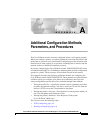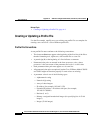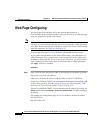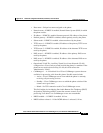
A-9
Cisco IP Phone Administration Guide for Cisco CallManager 3.3, Cisco IP Phones 7902G/7905G/7912G
OL-6313-01
Appendix A Additional Configuration Methods, Parameters, and Procedures
Web Page Configuring
• Host name—Unique host name assigned to the phone.
• Domain name—If DHCP is enabled, Domain Name System (DNS) in which
the phone resides.
• IP address—If DHCP is enabled, Internet protocol (IP) address of the phone.
• Default gateway—If DHCP is enabled, default gateway used by the phone.
• Subnet mask—If DHCP is enabled, subnet mask used by the phone.
• TFTP server 1—If DHCP is enabled, IP address of the primary TFTP server
used by the phone.
• TFTP server 2—If DHCP is enabled, IP address of the alternate TFTP server
used by the phone.
• DNS server 1—If DHCP is enabled, IP address of the primary DNS server
used by the phone.
• DNS server 2—If DHCP is enabled, IP address of the alternate DNS server
used by the phone.
• Operational VLAN ID—Auxiliary Virtual Local Area Network (VLAN)
configured on a Cisco Catalyst switch in which the phone is a member. If the
phone has not received an auxiliary VLAN, this field reflects the
Administrative VLAN.
• CallManager 1 – 4—Prioritized list of Cisco CallManager systems that are
available for processing calls from this phone. Possible states include:
–
Active—Cisco CallManager server from which the phone is currently
receiving call-processing services.
–
Standby—Cisco CallManager server to which the phone switches if the
current server goes down.
–
Blank—No TCP connection to this Cisco CallManager server.
This field might also include the Survivable Remote Site Telephony (SRST)
designation, indicating an SRST router that assumes control of call
processing if all other Cisco CallManager servers are unreachable.
• DHCP enabled—1 if DHCP is enabled. 0 if not.
• DHCP address released—1 if the DCHP address is released. 0 if not.


















